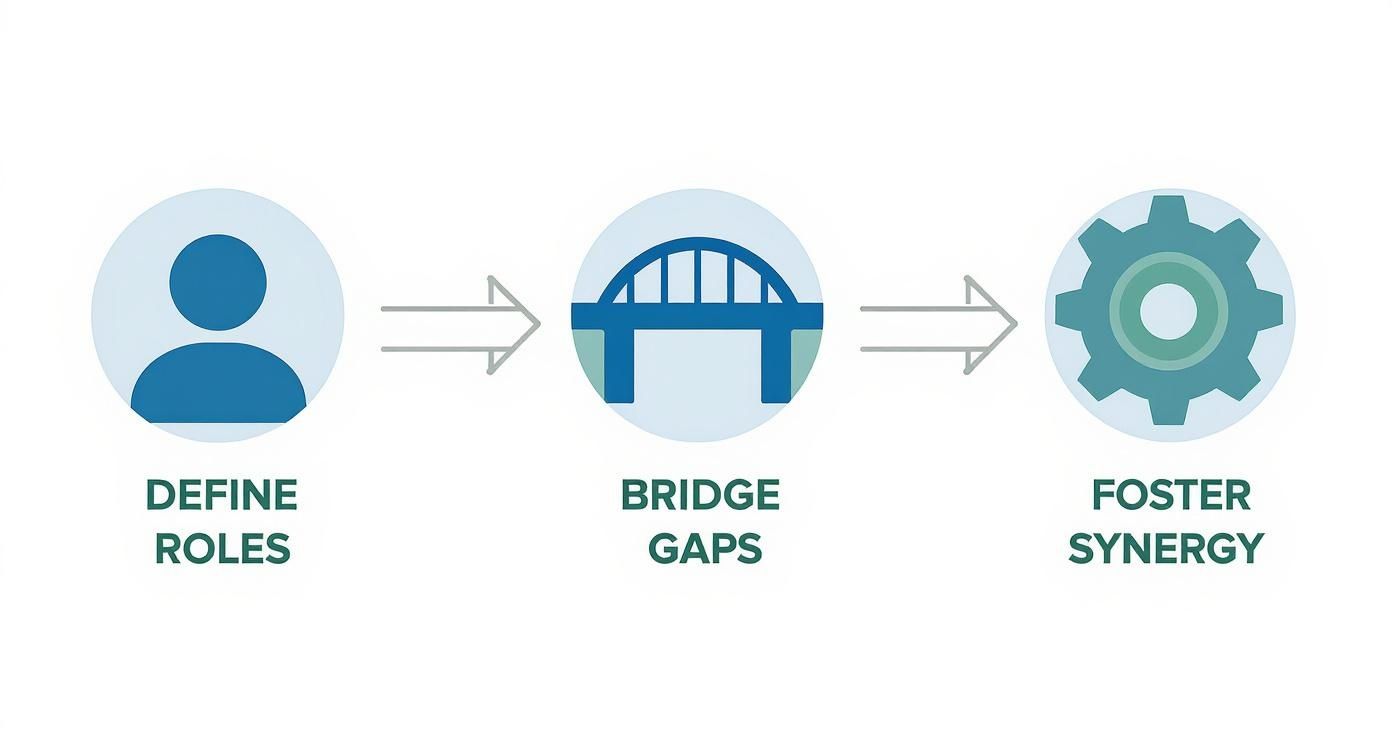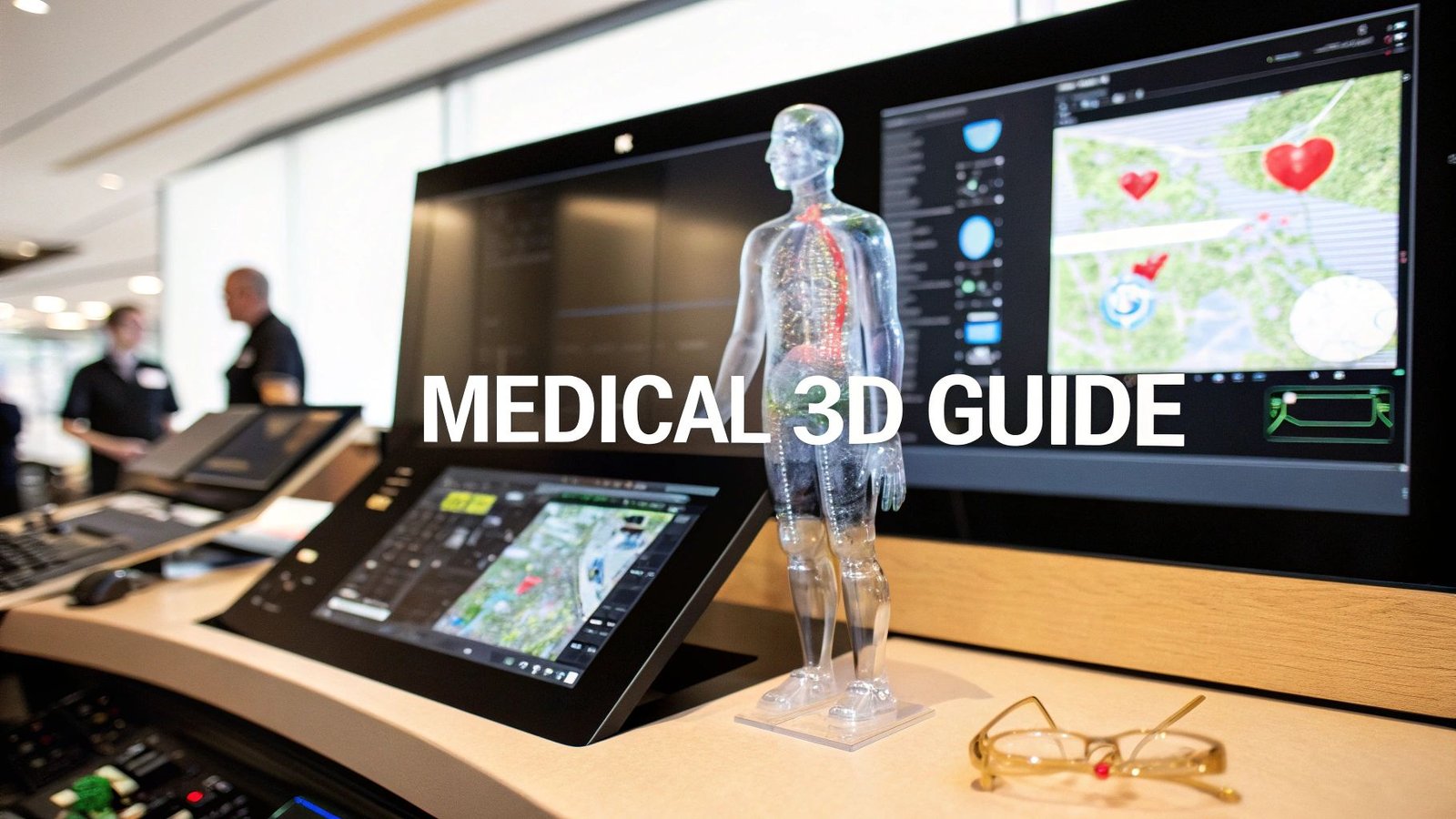Managing IT projects in healthcare isn't just about applying standard project management principles. It's a whole different ballgame. You're working in a high-stakes world where technology, strict regulations, and patient safety all intersect. Think about guiding a major EHR upgrade or launching a new telehealth platform—it’s about steering these complex initiatives from a simple idea to a fully functional, compliant, and life-improving reality.
Why Today’s Healthcare IT Projects Need a Smarter Playbook

Healthcare is in the middle of a massive digital overhaul, which puts a huge spotlight on skilled IT project management. This isn't like rolling out a new retail app. In our world, a small mistake can have serious consequences for patient care. These aren't just tech projects; they're about people, deeply ingrained clinical processes, and sometimes, life-or-death decisions.
This new reality demands a fresh perspective. Your classic, by-the-book project management techniques often don’t hold up against the unique pressures of the medical field. For example, getting a new telehealth platform off the ground means more than just making sure the video works. It has to be ironclad against HIPAA violations and integrate flawlessly with the existing electronic health records (EHRs) that are the lifeblood of the clinic.
The High Stakes of Healthcare Innovation
I’ve seen it firsthand: the biggest challenge is getting everyone on the same page. You have clinicians laser-focused on patient outcomes, administrators scrutinizing every line of the budget, and IT specialists deep in the weeds of system architecture. The real art is bridging those communication gaps and weaving their different priorities into one unified strategy.
This is something we live and breathe at PYCAD. When we at PYCAD, build custom web DICOM viewers and integrate them into medical imaging web platforms, there’s zero room for error. Flawless execution isn't just a nice-to-have; it's the bare minimum. You can see how this meticulous focus plays out in our PYCAD portfolio.
Success in healthcare IT isn’t measured just by finishing on time and on budget. It’s about delivering solutions that clinicians actually trust, administrators fully back, and patients ultimately benefit from.
The pressure is only going to grow. The global healthcare IT market is on a rocket ship, projected to climb from around $360 billion to over $730 billion by 2029. This boom is all about replacing clunky, outdated systems with smarter technology. If you want to get a better sense of this shift, you can find great insights on digital transformation in healthcare. This explosive growth makes sharp, effective IT project management a must-have skill for any healthcare organization that wants to lead the pack. For more on what's ahead, check out the 2025 global health care executive outlook.
Building a Bulletproof Project Foundation

The fate of a healthcare IT project is often sealed long before anyone writes a single line of code. Real success isn't about the technology alone; it’s forged in the planning room, through deep discovery and a relentless focus on strategic alignment. This isn't just about paperwork. It's about building a shared vision strong enough to weather the storms that will inevitably come.
Think of the project charter as your North Star. This document goes beyond simple objectives; it clearly defines the project’s boundaries, what success actually looks like, and the metrics you'll use to prove it. It forces you to answer the tough questions from day one: What problem are we really solving here? Who benefits? And how will we know, without a doubt, that we've won?
Mapping the Human Element
Once you have your charter, the real work begins: mapping the human landscape. Every project touches countless individuals, and understanding their motivations, fears, and expectations is non-negotiable. I've seen more projects fail from people problems than technical ones.
Your stakeholder map is your guide to navigating these complex relationships. It needs to be brutally honest and include everyone:
- Clinical Champions: The physicians and nurses who will advocate for the change because they see its potential to improve patient lives.
- Administrative Gatekeepers: Department heads who are laser-focused on budgets and keeping operations running smoothly.
- End-User Skeptics: The veteran front-desk staff or lab techs who have seen "the next big thing" come and go and are wary of another disruption.
- IT Infrastructure Teams: The unsung heroes concerned with security, performance, and keeping the data flowing correctly.
Knowing who's in each camp allows you to build bridges, anticipate resistance, and communicate in a way that resonates with what they care about most. This isn't manipulation; it's smart collaboration.
Proactively Identifying Risks
Finally, a solid foundation demands a clear-eyed look at what could go wrong. The healthcare space is a minefield of potential risks, from shifting regulations to entrenched legacy systems. Pretending these don't exist is a direct path to failure.
A well-crafted risk assessment doesn't just list potential problems; it prepares your team to face them with confidence and agility, turning unforeseen challenges into manageable tasks.
Common risks in healthcare IT project management are things like nightmarish data migrations, sudden compliance changes, and the ever-present interoperability puzzle. For example, getting a new platform to talk to an old, stubborn EMR system is a classic roadblock. Understanding the nuances of https://pycad.co/healthcare-interoperability-solutions/ is crucial here.
The best way to tackle these giant challenges is to break them down. Exploring different Work Breakdown Structure examples is a fantastic way to see how you can deconstruct a massive undertaking into a clear, step-by-step plan. This meticulous planning is precisely how we at PYCAD build custom web DICOM viewers and integrate them into medical imaging web platforms, making sure every detail is buttoned down from the very start.
Putting Together Your A-Team: The People Behind the Project
Let's be honest: even the most groundbreaking project plan is just a piece of paper without the right people to make it happen. The success of any healthcare IT initiative truly comes down to the team. And in this world, that means building a powerhouse group that bridges two very different cultures: the clinical frontline and the technical back end.
The real trick is that these two groups often feel like they're speaking completely different languages. A surgeon's frustration with slow image loading times has to be translated into clear, technical specs for a developer. A nurse’s gut feeling about a clunky interface needs to become concrete feedback for a designer. This is where a truly blended, multidisciplinary team doesn't just help—it changes the entire game.
Build Bridges, Not Silos
The age-old divide between the clinical staff and the IT department is probably the single biggest threat to any project's momentum. To tear down those walls, you need more than a weekly check-in meeting. You need to create specific roles for people whose entire job is to translate, mediate, and make sure nothing gets lost in the process.
Think of it this way:
- Clinical Liaisons: These are your champions on the floor. They're often tech-savvy nurses, physicians, or therapists who live and breathe the clinical workflows. They act as your ambassadors, gathering feedback from their peers and making sure the final product actually makes life easier for the people providing care.
- Technical Translators: On the IT side, you need analysts and engineers who are genuinely curious about the why behind a request. They don’t just build what they’re told; they dig deeper to understand the clinical context, which often allows them to suggest even better, more innovative solutions.
The goal isn't just to get people to collaborate; it's to get them to co-create. When your clinicians and developers start seeing themselves as one team fighting for the same goal, you hit a level of innovation that siloed departments could only dream of.
This synergy is what we live for at PYCAD. When we at PYCAD, build custom web DICOM viewers and integrate them into medical imaging web platforms, our developers are in a constant conversation with our clients' clinical experts. This partnership is what creates real results, and you can see that technology shaped by direct clinical insight in our PYCAD portfolio.
Thriving in the New Remote World
The way we work together has fundamentally changed. Healthcare IT, in particular, has seen a huge shift toward remote and hybrid teams. In fact, over a third (35%) of healthcare project managers now work completely from home. Less than 20% are fully in-person, which is the highest rate of remote-only project managers you'll find in any industry. If you're curious, you can find more insights on project management statistics that highlight this trend.
This new reality means you have to be incredibly intentional about communication. You can't just rely on bumping into someone in the hallway anymore. You need the right digital tools and crystal-clear processes to keep a team spread across different locations connected, aligned, and moving forward as one. The last thing you want is for physical distance to create a whole new set of digital silos.
Executing Your Project with Precision and Agility
https://www.youtube.com/embed/T9zmFHQOrdM
You've laid the groundwork and assembled your A-team. Now it's time to bring your vision to life. This is where the real rhythm of healthcare IT project management begins—the daily sprints, the quick check-ins, and the nimble adjustments that transform a solid plan into a successful reality. Think of this phase less as rigidly following a manual and more as cultivating a culture of focused, agile execution.
The right tools are your best friends in managing what can feel like controlled chaos. Don't underestimate their impact. Companies using project management software complete 61% of their projects on time, a massive leap from the 41% rate for those who don't. To keep your project on track, it's worth exploring proven IT project management best practices. With the market for these tools growing at nearly 10% annually, platforms like Jira—which is already used by 42% of teams—have become indispensable for navigating complex initiatives.
Essential Tools for Healthcare IT Project Management
Choosing the right software can feel overwhelming, but the key is matching the tool to your team's specific workflow and the project's unique demands. Here’s a quick breakdown of some of the heavy hitters and where they shine in a healthcare setting.
| Tool | Primary Use Case | Key Healthcare Feature | Best For |
|---|---|---|---|
| Jira | Agile Development & Bug Tracking | Customizable workflows for complex clinical software development and validation processes. | Teams building custom EHR modules, medical imaging software, or other complex clinical applications. |
| Asana | Task & Workflow Management | Visual timelines (Gantt charts) for tracking dependencies between clinical and IT teams. | Managing EHR implementation schedules, coordinating training sessions, and tracking departmental readiness. |
| Trello | Visual Kanban-Style Management | Simple, card-based system for visualizing workflow stages, from 'To Do' to 'Complete'. | Smaller projects, departmental task forces, or managing help desk tickets during a go-live event. |
| Smartsheet | Spreadsheet-Style Project Mgt. | HIPAA-eligible platform with robust reporting and dashboarding for compliance tracking. | Managing budgets, resource allocation, and creating high-level executive reports on project status. |
Ultimately, the best tool is the one your team will actually use. Run a few small pilots to see what sticks before committing to a platform for a major project.
Mastering Your Project Cadence
Every successful project has a heartbeat—a consistent cadence of communication that keeps everyone perfectly in sync. This isn't about scheduling more meetings; it's about making every interaction count.
Take the daily stand-up. It should be a high-energy, 15-minute huddle focused on just three things from each person:
- What did I accomplish yesterday?
- What am I tackling today?
- What's standing in my way?
Beyond the daily huddles, your reporting needs to be sharp and tailored. Executive sponsors don’t want to see a 100-item task list; they need a clean dashboard showing progress against major milestones, budget burn rate, and any red-flag risks. Your project team, on the other hand, needs that granular view in Jira or a Kanban board to manage their work effectively.
The art of execution is all about getting the right information to the right people at the right time. Your job is to create clarity, not noise. When you do that, you empower everyone on your team to make smart decisions.
This is why building the team correctly from the start is so critical.

As the visual shows, you start with clear roles, then intentionally bridge any gaps, which naturally fosters the synergy needed for agile execution.
Leading Through Change with Empathy
Let's be honest: no healthcare IT project is just about technology, especially when it involves patient data. It's a deeply human endeavor that changes how clinicians work. Your success hinges on guiding your users—the nurses, doctors, and lab techs on the front lines—through this transition with genuine empathy.
Get them involved early and listen to what they say. Run pilot programs with your clinical champions, ask for their brutally honest feedback, and demonstrate how this new system will make their incredibly demanding jobs easier, not harder.
Success is ultimately measured by adoption. A technically perfect system that no one uses is a failure. By treating clinicians as partners in the process, you turn potential skeptics into your biggest advocates. This ensures the technology isn't just implemented—it's truly embraced. And as you work with these systems, remember that a deep understanding of https://pycad.co/hipaa-compliant-data-transfer/ is non-negotiable for protecting patient privacy every step of the way.
From Go-Live to Lasting Impact

The day a new system goes live isn't the finish line. Far from it. It's really the starting block for creating genuine, lasting value. The true test of any healthcare IT project management success story is what unfolds after the launch-day excitement fades. It's about making sure the new technology doesn't just work—it flourishes, actively improving patient care and making daily life easier for clinical teams for years to come.
Getting to that point hinges on a rock-solid go-live strategy. Your team needs more than a date circled on the calendar; they need a playbook. One that prepares them for the inevitable bumps in the road and gives them the confidence to handle them. Think of it as a pre-flight checklist: final data validation, contingency plans for unexpected slowdowns, and a clear communication tree. When you've already answered "Who's on call?" and "How do we get the word out?", you turn potential chaos into a measured, professional response.
Building Trust When It Matters Most
The moment the system is live, the spotlight instantly shifts to support. This is where you win the hearts and minds of your users. A responsive, empathetic post-launch support system is absolutely essential for building their confidence. Clinicians and staff need to feel supported and heard, not like they've been left to figure it all out alone.
A strong support framework is built on a few key pillars:
- A "Hypercare" Period: For the first couple of weeks, you need an all-hands-on-deck approach. Have experts on-site or just a quick call away to squash bugs, answer questions, and calm nerves in real-time.
- Clear Lines of Communication: Nothing is more frustrating than not knowing who to call. Make sure every single user understands the escalation path for different issues. It saves time and prevents small problems from boiling over.
- Proactive Outreach: Don't just sit back and wait for help tickets to flood in. Get out there and talk to people. Check in with different departments. Ask them what's working and what isn't. You'll catch minor annoyances before they become major headaches.
This isn’t just theory; it’s how we operate every day. Here at PYCAD, when we build custom web DICOM viewers and integrate them into medical imaging web platforms, our partnership is just getting started at launch. We stick around to make sure the technology is fully adopted and fine-tuned for real-world use, as our portfolio of successful projects shows.
Measuring What Truly Matters
In the end, success isn't just about a smooth rollout. It's about proving the project made a real difference in the things that matter most: patient outcomes and clinical efficiency. To do that, you have to track the right Key Performance Indicators (KPIs) after you go live.
Your project’s legacy isn’t the technology itself, but the measurable improvements it brings to healthcare delivery. Capturing and communicating this value is the final, crucial step in your journey.
Move beyond basic metrics like system uptime. Instead, focus on things like reduced patient wait times, faster turnaround for diagnostic reports, or a drop in administrative errors. When you can draw a straight line from your new tech to these core healthcare goals, you don't just justify the investment—you uncover priceless insights that will fuel the success of every project that follows. This is how a single project can spark a culture of continuous improvement.
Your Top Healthcare IT Project Management Questions, Answered
Jumping into a healthcare IT project can feel like navigating a maze in the dark. The technology is complex, the stakes for patients and providers are sky-high, and it’s easy to feel overwhelmed. Let's shine a light on some of the most common questions I hear from leaders, giving you the practical, real-world answers you need to move forward with confidence.
What Are the Biggest Risks I Should Watch Out For?
Every project has its hurdles, but in healthcare IT, a few risks stand head and shoulders above the rest. Beyond the standard budget and deadline pressures, you need to be hyper-vigilant about these three:
- Data Security: This is the big one. A security breach isn't just a technical hiccup; it’s a fundamental betrayal of patient trust that can lead to devastating regulatory fines and permanently damage your reputation.
- Poor Interoperability: Imagine spending millions on a brilliant new system that can’t talk to your existing EHR or diagnostic tools. It's a shiny, expensive paperweight. If systems can't share data seamlessly, the project is dead on arrival.
- Low User Adoption: This is the silent killer of so many projects. You can build the most advanced tool in the world, but if doctors, nurses, and other clinical staff find it clunky or disruptive to their workflow, they’ll find a way to work around it. And then, all your effort is for nothing.
Should We Go With an Agile or Waterfall Methodology?
This is the classic "it depends" question, but the answer really hinges on the nature of your project. There's no single right answer, just the right fit for the job.
The Waterfall method, with its rigid, step-by-step progression, is actually perfect for certain healthcare projects. Think of a large-scale EHR implementation. The requirements are well-defined and there's a mountain of regulatory compliance to consider, making a structured, linear approach a safe and predictable bet.
On the other hand, Agile is your best friend when you expect things to change. If you're building a new patient engagement app, for instance, you want to be able to iterate. Using sprints lets you release features, get immediate feedback from real users, and pivot quickly. Honestly, the most successful teams I’ve worked with blend the two, using a hybrid approach that combines Waterfall's big-picture planning with Agile's flexibility during the development sprints.
What Skills Make a Great Healthcare IT Project Manager?
Standard project management skills are just the ticket to entry. The project managers who truly excel in this space are a special breed.
First and foremost, they are master communicators. They have to act as a translator, fluently speaking the language of both software engineers and clinical staff, ensuring nothing gets lost in translation.
They also have a deep, genuine understanding of clinical workflows. You simply can't lead a project effectively if you don't grasp the day-to-day reality of the people who will be using your technology. And of course, a rock-solid knowledge of regulations like HIPAA is non-negotiable.
The most impactful healthcare IT project managers are more than just organizers; they are empathetic leaders who can align technology with the human mission of patient care.
How Can We Guarantee Our Custom Software Integrates Smoothly?
Here's the secret: seamless integration is never an accident. It’s the result of relentless, proactive collaboration from the moment the project kicks off.
You can't just build a piece of software in a silo, toss it over the fence, and hope it connects. This demands a true partnership between your development team and the client's IT and clinical experts.
At PYCAD, this is the core of how we operate. When we at PYCAD, build custom web DICOM viewers and integrate them into medical imaging web platforms, we are embedded with our clients' teams from day one. We meticulously map out every single integration point and conduct exhaustive interoperability testing to ensure our viewers communicate flawlessly with existing PACS and EMR systems. You can see the results of this deeply collaborative approach in our portfolio.
At PYCAD, we specialize in turning complex healthcare IT visions into reality. Our expertise in creating custom medical imaging platforms with integrated DICOM viewers ensures your project not only meets but exceeds expectations.
Explore our work and see how we can help you innovate.






